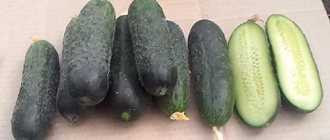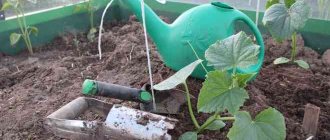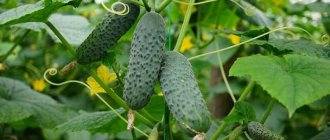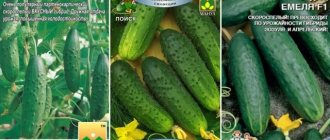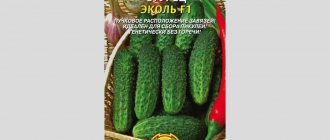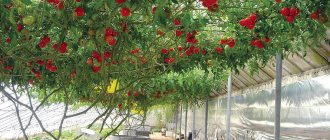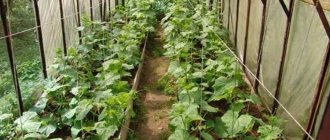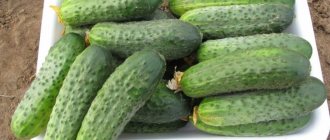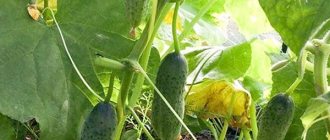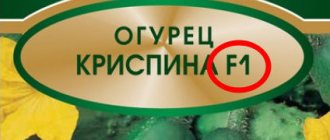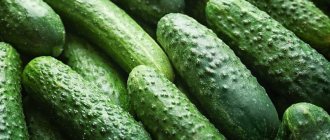Cucumber Spino F1 is a high-quality greenhouse hybrid that shows good results in open ground. It was created so that gardeners and farmers can save time on care and get a wonderful harvest without extra effort.
| Landing location | Ripening time | Mode of application | Fruit length | Group | Fruit smoothness | Pollination method |
| Universal | Early ripening (35-45 days) | Universal | Medium - from 10 to 15 cm | Hybrid | Highly lumpy | Parthenocarpic |
Description of the variety
The Spino cucumber hybrid was bred in Holland and has a number of qualities that distinguish it from other cucumber varieties. It has the following characteristics:
- early ripening, produces a harvest 30-40 days after planting in the ground;
- grows in all regions regardless of climate zone;
- feels good both when grown in a greenhouse and in open ground;
- can grow and bear fruit in the shade;
- The fruits are dark green, up to 15 cm long, without bitterness.
Spino cucumbers can be eaten fresh and pickled for the winter. When salted and marinated, they retain their shape perfectly, remain crispy and elastic.
Description
The plant is indeterminate, of a generative type of development. The main stem of the variety has short internodes, which contributes to the formation of more ovaries. The number of side shoots is minimal. The leaf blade is medium-sized, green, slightly wrinkled. The stalk is long. Spino flowering type is female, fruiting type is bouquet. According to the State Register description, 1 - 2 female flowers are formed in each leaf node of a cucumber. The originator claims 3 - 5 ovaries.
The fruits are short, almost the same length (12 - 14 cm), cylindrical in shape. The skin is green, with medium stripes, although the originators describe the color as uniform, without stripes. The surface of the greens is covered with large tubercles, the pubescence is light, and the spines are large. The pulp has a pleasant consistency, dense and crispy, has excellent taste and is completely free of bitterness. Cucumber weight 81 - 86 grams.
Advantages and disadvantages
The advantages include the following:
- from 1 sq. m you can collect up to 15 kg of high-quality fruits;
- the fruits have a good presentation;
- cucumbers of this variety can be stored for a month, which allows them to be transported over long distances;
- plants are not exposed to diseases characteristic of this type of crop;
- overripe fruits do not take on a barrel shape, but remain cylindrical and smooth;
- The plant is generative, compact, and does not tend to grow much, so it does not require much space for cultivation.
During the cultivation of the hybrid, no negative qualities were identified.
Advantages of the variety
The hybrid has many positive qualities. Gardeners highlight the following characteristics:
- Possibility of obtaining a high yield if growing conditions are met.
- Attractive appearance of the fruit and excellent taste.
- Possibility of long-term storage of the harvested crop.
- Suitable for long distance transportation.
- Untimely harvesting of fruits does not affect the appearance of cucumbers.
- Persistent immunity to diseases of representatives of the pumpkin family.
It is necessary to exercise timely control over the number of ovaries so that the flowers do not fall off.
Soil requirements
Soil with high acidity is not suitable for Spino cucumbers. They need either a neutral or slightly alkaline environment. Sometimes a slightly acidic one is allowed, but only if there is no other one.
You can determine the acidity of the soil at home using soda and vinegar. Acidic soil will foam when mixed with soda, and alkaline soil will foam when mixed with vinegar. If there is no reaction, then the environment is neutral.
If the soil is acidic, you can deoxidize it by adding ash, lime, and gypsum to the soil. If this is not done, the plants will wither and dry out early.
Also, the soil must be saturated with nutrients. To do this, it is mulched with organic matter or fertilizers are added.
Quickly view images of cucumber varieties
Cucumber Army F1
Cucumber Anticipator F1
Cucumber Nutcracker F1
Cucumber Shalunishka F1
Cucumber Crispy slice F1
Cucumber Crunchlandia F1
Cucumber Spino F1
Cucumber Cedric F1
Cucumber Provencal capital F1
Cucumber Platov F1
Cucumber Picolino F1
Cucumber Neva F1
Cucumber Monsieur Olivier F1
Cucumber Marina F1
Cucumber Malachite box F1
Cucumber Lukhovitsky F1
Cucumber Gourmand F1
Cucumber Kumbor F1
Cucumber Corinto F1
Cucumber Claudia Agro F1
Cucumber Kapitoshka F1
Cucumber Joelina F1
Cucumber Dr 8986 cb F1
Cucumber Donchak F1
Cucumber Landing F1
Cucumber Deria F1
Cucumber Ladies' Man F1
Rules for sowing seeds and planting seedlings
Spino cucumber seeds are planted in the ground to a depth of 2-3 cm. If planting is carried out in open ground, the soil should be warmed to at least 12 degrees. If this condition is not met, the seeds will not sprout, but will simply rot in the ground.
Seeds are sown for seedlings in special cassettes, containers or plastic cups. They are filled with soil taken from the surface of the soil and mixed with peat and sand in a ratio of 3:1:1.
Usually they sow one seed at a time, but if you have a supply of seeds, you can sow two in one container. After germination, the stronger plant should be left and the weaker one should be removed.
It is not recommended to keep seedlings in a container for a long time - they should be planted when 3-4 leaves form, not later. The roots of a cucumber are straight, and if the seedlings are kept in a container for a long time, the root bends and the quality of the seedlings deteriorates.
Before planting seedlings in the ground, they must be hardened off, otherwise they may burn in the sun. For 1 sq. m it is allowed to plant 2 plants. With denser plantings, the yield decreases.
Landing rules
The variety is best grown in seedlings
Seeds do not require preparation for planting. That is, the gardener does not have to germinate the seeds, treat them with chemicals or heat them.
Landing is carried out in accordance with weather conditions. It is important to pay attention to the quality of soil heating. Its temperature should be at least 20°C. Seeds must be planted in separate containers and at a distance of 20 cm from each other. If you plant them closer, the yield will drop significantly. The depth of penetration of seeds into the hole is 2 cm. After planting, the hole must be watered with warm water. It is also necessary to mulch the planting material with peat or manure waste.
Soil for planting seedlings should only be used that has a surface layer of peat. After this, you need to put a small amount of limestone or complex fertilizers on top of the soil. A few days before planting, the soil should be treated with special substances that will prevent the root system from rotting. The seedlings are planted in the soil to a depth of about 2 cm. In order to prevent a film from appearing on the plant, which will block the flow of moisture and air, it is necessary to cover the planted material with a film. It is best to use seedlings that already have several formed leaves. There should be no more than 2 plants per 1 m2. This will prevent them from twisting among themselves.
Diseases and their prevention
The Spino variety is considered resistant to diseases that are typical for cucumbers. But with high humidity and rainy summers, it is useful to take preventive measures.
Plant bushes are sprayed with preparations containing copper. The best varieties for this variety are Kurdan, Gamair and Thanos. They generously treat the surface of the stems and leaves in dry weather so that the plants have time to absorb the substances needed for protection. If it rains after spraying, the protective layer will be destroyed and preventive treatment will need to be carried out again.
Preventive measures will help avoid premature yellowing of fruits, which can occur in dry weather.
Agricultural technology
The Spino variety is resistant to sudden temperature changes and is stress-resistant, so it is in great demand. These points eliminate problems during transplanting seedlings to the garden bed, which in other varieties is accompanied by:
- decreased immunity;
- the formation of diseases;
- deterioration of general condition;
- weakness of the root system and death.
Despite the fact that the variety was bred by breeders, it requires constant care. It is better to grow in a greenhouse where there is no access to bees. It is better to first prepare the seedlings and only then replant them. For germination, you need to purchase peat pots and seeds, for which you choose specialized sales points where they can offer certified products.
Note!
Seeds do not need to be soaked in a manganese-based solution, but it should be used as a preventive measure during soil disinfection.
If you don’t have potassium permanganate at hand, then it is permissible to use products created in industrial conditions. The substrate for planting should consist of 50% humus, and the seeds are placed with their sharp tip upwards in the hole to a depth of 13-20 mm.
You may be interested in:
Planting cucumber seedlings in open ground: step-by-step instructions For gardeners, planting cucumber seedlings in open ground is the most difficult stage in growing a crop. Her landing...Read more...
The dimples are watered with warm water, and the pots are covered with film. Place in rooms with an air temperature of at least +20 °C. When the first sprouts appear, the film is removed.
To select planting dates, you can use:
- lunar calendar;
- recommendations of breeders;
- climatic features of the region.
If a summer resident has the opportunity to provide the plant with proper care, then the seeds are planted even in February. But more often this is done in mid-March - early April. Transplanting into the ground is permissible when the sprouts have about 5 true leaves.
Soil disinfection is done when planting seeds or transferring peat pots to greenhouse conditions. The sprouts need to be positioned 20 cm relative to each other, and a distance of 50 cm is sufficient between the rows. If the seedlings are not in pots, but in plastic containers, then the division of the bushes is done carefully.
When growing without seedlings, trenches are made in the beds and seed material is laid out at intervals of 25 cm. A space of 35 cm is left between future bushes so that they do not interfere with each other during growth and active development. Sowing seeds in the ground is permissible when:
- the soil is well heated;
- Frosts are excluded, which is important for the last days of May.
4-5 seeds are placed in holes 18-20 mm deep.
Water by drip method. Moisturize every day, the water should be warm and settled. Deficiency and excess of water are harmful.
Attention!
Watering during the solstice will cause burns on the foliage, so it is better to choose morning or evening hours.
The following rules must be observed:
- Loosen 2-3 times a week.
- If the soil is heavy and crusty, loosen it every time after watering.
- As soon as the plant reaches a height of 25-35 cm, it needs to be tied up so that the lashes do not lie on the ground, do not get tangled, or rot. For gartering, trellises are dug in next to the bushes.
- For fertilizer, use fertilizers of mineral and organic types, and they need to be alternated and use only those compositions that are developed for cucumbers. For dilution and application, you must carefully follow the instructions for use. The main principle in this stage of care is regularity and moderation.
Most formulations contain large amounts of potassium and nitrogen. Substances are necessary to accelerate the growth and development of plantings, and to speed up the period of fruit formation. For each growth phase, their own feeding is used.
If there are a lot of weeds in the garden, the harvest will take a long time. The roots will suffer due to the pressure of weeds and will gradually begin to die off, as they will not be able to receive useful microelements.
Harvesting and storage rules
Harvesting Spino cucumbers is easy because the fruits do not ripen as quickly as other varieties. If some of the cucumbers go unnoticed during harvesting, they will not lose their presentation until the next harvest.
Thanks to these qualities, the harvest can be harvested not every day, but once every 3-4 days. Harvesting begins a month and a half after planting and continues for a long time until the bushes dry out.
Spino cucumbers store well for a long time, but they should not be kept in the sun or in places with high humidity. They also do not tolerate storage well in closed containers. It is best to store them in small boxes in a dry place with good ventilation. It is better to harvest in dry weather, since cucumbers collected in the rain are not stored as well.
The hybrid variety Spino is an excellent new product that can displace many popular varieties of cucumbers from the world market. It gained recognition not only from gardeners, but also from large farmers, who appreciated the variety for its unpretentiousness and productivity.
0
0
Copy link
Care
Spino f1, according to the description, is an undemanding variety and not capricious in terms of care. The main thing it needs is abundant watering, treatment against weeds and regular nutritional feeding. With proper care, the cucumber will ripen quickly and will delight you with a high-quality harvest.
Watering
This variety, like all representatives of the culture, loves water. Spino needs to be watered every other day, using a drip method. According to the description, morning, evening, and sunset hours are best suited for this procedure, when the sun is inactive. The ideal water temperature for cucumbers is 24°-25°, and it must sit for half an hour before watering.
Garter and bush formation
Since we are talking about a predominantly greenhouse variety, it is tied to trellises as soon as the shoots reach 20-23 cm. The Spino f1` bush is formed by the central stem, the lower leaves are blinded up to the 6th leaf. Most of the side shoots are removed, but you can leave 3-4 sprouts up to the 3rd leaf so that the cucumber bears fruit better.
Top dressing
Spino prefers organic and nitrogen-phosphorus fertilizers. Fertilizing of plantings of the variety is carried out once every 10-14 days. For the first fertilizer, 10 days after planting, chicken manure is good. During the period of active growth of bushes, the cucumber is fed with potassium nitrate and ash.
During flowering and fruiting, it is recommended to use superphosphate and humus.
Hilling
Sprinkling with soil helps strengthen the root system, save the plantings from the wind, and additionally moisten the roots of the variety. The first hilling of Spino f1 is carried out as soon as the sprouts reach a length of 10 cm - the cucumber is covered 2/3 with earth. Subsequent sprinklings are carried out every week, during dry periods - every 5 days.
Features of growing seedlings and seeds
Early ripe cucumber “Spino f1” can be grown by direct sowing of seeds in soil heated to optimal temperatures, adhering to the following recommendations:
- the seed material sold by these companies has already undergone high-quality treatment with the highly effective fungicidal preparation “Tiram” and does not require heating or pre-soaking, which is very convenient for gardeners;
- the timing of direct sowing of seeds should be determined primarily by temperature indicators and soil moisture parameters in the ridges;
- seed material is sown on open ground ridges when the soil is heated to 15-18 °C;
- hybrid cucumbers react poorly to thickened sowing, and under such conditions the plants exhibit poor development of lateral fruiting vines;
- depending on the method of cultivation, furrows or planting holes for cucumbers should be filled with a mixture, which must include peat, rotted manure, sand and high-quality mineral fertilizers;
- holes or furrows filled with the nutrient mixture should be watered generously with water heated to 25 °C;
- when sowing dry seeds, the sowing depth should be 1.5-2.5 cm;
- cucumber crops must be mulched with a mixture based on peat or rotted manure, and then covered with film.
When cultivating hybrid early-ripening cucumbers in glass, film or polycarbonate greenhouses and tunnels, sowing seed material can be carried out already in the first ten days of May, adhering to the standard scheme.
Seedlings can be planted 25 days after sowing, therefore, taking this feature into account, the time for working with planting material is determined. When planting in the ground, the soil temperature should be at least 17 C. The seedlings should not be allowed to stretch and thin, as such shoots will not give a good harvest.
When planting seeds in the ground, it is important to choose the right time for planting. It is necessary to have a sufficient degree of soil heating and no threat of frost. When planting by sowing seeds into the ground, the quality of the beds plays an important role. Their recommended height is considered to be from 15 to 20 cm. There should be a distance of at least 1 meter between each bed. When planting, you should be guided by a scheme in which there should be a distance of 25 to 45 cm between each shoot.
